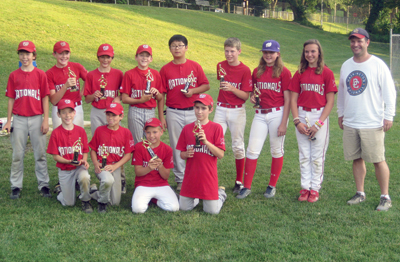Our 14U baseball team from Charlotte rolled into the hotel on Thursday evening, an hour after having played our opening game in the Impact national championship. In travel baseball, every tournament is dubbed a global championship, a world series, a national championship or a state championship. The fancier the name, the more teams might enter, even though the name of the event really doesn’t matter at all.
I coach and manage a team called the Carolina Express, so making out the schedule is one of my responsibilities. Until now, I had not really thought about the combined costs of traveling to a tournament, but it’s an interesting exercise.
We entered this late-June tournament for the promise of playing quality competition from North Carolina and Virginia at nice facilities in the Raleigh area. The promoter advertised that the University of North Carolina baseball field would be among the facilities in the rotation, along with historic Durham Athletic Park, Louisburg College and some local high schools. Sounded good to me.
We, like the other 20 teams in the field, paid a $750 entry fee, a pretty hefty price tag but really not that out of line these days. Friends of ours paid $1,500 per team to play in an East Cobb tournament just outside of Atlanta. By the way, it’s not unusual to drive hundreds of miles to these tournaments and then face a team that’s based in the same town you’re from.
Part of the team’s obligation is to use the tournament-sponsored hotel. In this case, it was a SpringHill Suites.
 |
Smith knows firsthand how pricey youth sports can become.
|
Perfect, Marriott points. Rarely do we get so lucky.
We played our first game at Louisburg College against a team from Maryland. One of the quirks of this tournament is that the teams must supply the baseballs. It’s standard to put about three new baseballs into play at the start of a game, so you typically take a dozen baseballs to a tournament. A dozen high school-certified baseballs cost about $60.
On the first pitch, the batter fouled one over the first base dugout, deep into the woods behind a fence. One pearl gone. This became a trend.
We were rummaging through our baseball bucket for decent balls by the third inning. That’s not how you want to spend your afternoon after paying $750 just to enter. A visit to Dick’s Sporting Goods became part of the postgame plan.
We also learned that the UNC field would not be part of the rotation because the Tar Heels were playing in the College World Series, which created a staffing situation. That left us playing three of our four games at Louisburg, a 50-minute drive each way from our tournament-recommended hotel.
In all, we spent $750 on entry fees, $2,600 with the hotel for our 13 families, $120 on baseballs, $2,000 in the area restaurants and hundreds more in gas. Multiply that times 20 teams and you can begin to see the type of money these teams pump into a tournament and the host’s partners.
That’s the nature of youth baseball these days. Baseball, in many ways, is now mimicking the travel basketball circuit. The number of miles logged each summer has become more important than the won-loss record.
Michael Smith (msmith@sportsbusinessjournal.com) covers college sports and golf for SportsBusiness Journal.
By far, most of the adults associated with youth sports are normal, well-adjusted people. But stories of normal, well-adjusted people are not as much fun as the ones of grown-ups behaving badly.
In the past eight years of coaching my son’s baseball and basketball teams, I’ve seen fans threaten officials, fathers berate their kids and coaches lose their cool.
At a baseball tournament in Maryland last summer, the father of a 12-year-old boy screamed at me after a game my team won in the last inning. The man was enraged that I made some managerial moves to speed up the game. (Had a time limit taken effect, we would have lost.) The man was so threatening that I worried he might get physical in front of my kids. I didn’t engage and walked with my boys to the outfield while parents from the other team intervened to get the man off the field.
One of my favorite stories involves a Little League coach in his 20s, who decided to try a bit of gamesmanship by staring me down between innings at a rec league game in Washington, D.C. He was the third-base coach and walked over to our dugout, stood and stared directly at me. It was creepy enough that my heart started racing, wondering if there would be a confrontation in front of the kids. There wasn’t.
Another of my favorite stories occurred this past spring during Washington, D.C.’s Catholic Youth Organization
 |
Ourand stresses winning the right way.
|
baseball season. A gray-haired coach from a rival team that I had never met before refused to speak to me. When I asked him a question or notified him of a lineup change, he wordlessly would point to one of his assistants, who would come and deal with it. I’m still not sure if it was gamesmanship or a social tic, but I clearly wouldn’t want my son to learn some of life’s lessons from that type of coach.
There’s a push nowadays to moderate fan and coach behavior during youth sports games. That’s obviously a good thing. While these types of stories are the exception, they shape how people view youth sports.
In fact, they shaped how I viewed youth sports before my son started playing. These types of stories are exactly why I became so involved in my son’s teams. I wanted to shelter him as best I could from the types of coaches and fathers who were prone to lose their cool.
I think involvement in team sports is an important part of growing up. It helps kids figure out how to be successful in a team environment.
As coach, I stressed sportsmanship and fun above everything else. Everybody played on my teams, and everyone sat. But I coached to win. (Or, as I told parents, I would put their kids in positions to be successful.)
This year, some of the boys on the eighth-grade CYO basketball team I coached noted that I’ve never received a technical foul or even argued with officials. They begged me to run out on the court and argue a call, any call.
I didn’t, and that team made it to the finals of the postseason tournament. I hope the lesson the boys took away from the season is that you don’t have to yell, scream or behave badly in order to win.
John Ourand (jourand@sportsbusinessjournal.com) covers the media industry for SportsBusiness Journal.







